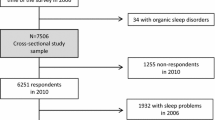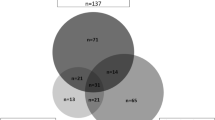Abstract
Objectives
The aim was to identify work factors that predict poor sleep in nurses’ aides (assistant nurses).
Methods
The study was based on a randomly selected, nationwide sample of Norwegian nurses’ aides. Of 5,513 nurses’ aides, not on leave when they completed a mailed questionnaire in 1999, 4,771 (86.5 %) completed a second questionnaire 3 months later. A wide spectrum of work factors was assessed at baseline by questions from the General Nordic Questionnaire for Psychological and Social factors at Work. Subjective sleep quality during the previous 3 months was measured at baseline and follow-up by a question from the Basic Nordic Sleep Questionnaire. Poor sleep was defined as the subjective experience of not sleeping well.
Results
Medium and high demands, high demand-control ratio, frequent exposure to role conflicts, and frequent exposure to threats and violence at work were associated with increased odds of poor sleep during the successive 3 months, after adjustments for sleep quality during the 3 months before baseline, other work factors, and background factors. High support from immediate superior, frequent rewards for well-done work, and high control of decisions that influence own work situation were associated with or tended to be associated with reduced odds of poor sleep.
Conclusion
Psychosocial work factors which are likely to produce sustained arousal, such as frequent exposure to role conflicts and violence, may contribute to poor sleep in nurses’ aides. Support and encouragement from superiors, and high control at work seem to reduce the risk of poor sleep.
Similar content being viewed by others
References
Addison RG, Thorpy MJ, Roehrs TA, Roth T (1991) Sleep/wake complaints in the general population. Sleep Res 20:112
Breslau N, Roth T, Rosenthal L, Andreski P (1996) Sleep disturbance and psychiatric disorders: a longitudinal epidemiological study of young adults. Biol Psychiatr 39:411–418
Cahill J, Landsbergis PA (1996) Job strain among post office mailhandlers. Int J Health Serv 26:731–750
Cajochen C, Zeitzer JM, Czeisler CA, Dijk D-J (2000) Dose–response relationship for light intensity and ocular and electroencephalographic correlates of human alertness. Behav Brain Res 115:75–83
Carskadon MA, Dement WC, Mitler MM, Guilleminault C, Zarcone VP, Spiegel R (1976) Self-reports versus sleep laboratory findings in 122 drug-free subjects with complaints of chronic insomnia. Am J Psychiatr 133:1382–1388
Coates TJ, Killen JD, George J, Marchini E, Silverman S, Thoresen C (1982) Estimating sleep parameters: a multitrait-multimethod analysis. J Consult Clin Psychol 50:345–352
Dallner M, Elo A-L, Gamberale F, Hottinen V, Knardahl S, Lindström K Skogstad A, Ørhede E (2000) Validation of the General Nordic Questionnaire (QPSNordic) for Psychological and Social Factors at Work, Nordic Council of Ministers, Copenhagen
Eriksen W, Tambs K, Knardahl S (2006) Work factors and psychological distress in nurses’ aides: a prospective cohort study. BMC Public Health 6:290
Estryn-Behar M, Kaminski M, Peigne E, Bonnet N, Vaichere E, Gozian C, Azoulay S, Giorgi M (1990) Stress at work and mental health status among female hospital workers. Br J Ind Med 47:20–28
Frankel BL, Coursey RD, Buchbinder R, Snyder F (1976) Recorded and reported sleep in chronic primary insomnia. Arch Gen Psychiatr 33:615–623
Fusilier MR, Ganster DC, Mayes BT (1987) Effects of social support, role stress, and locus of control on health. J Management 13:517–528
Gerster BI, Calmonte R, Noack H (1995) Schlafstörungen bei berufstätigen Männern and Frauen und ihre Beziehung zur Arbeitswelt. Sozial Präventivmedizin 40:275–284
Goldenhar LM, Swanson NG, Hurrell JJ, Ruder A, Deddens J (1998) Stressors and adverse outcomes for female construction workers. J Occup Health Psychol 3:19–32
Husby R, Lingjærde O (1990) Prevalence of reported sleeplessness in northern Norway in relation to sex, age, and season. Acta Psychiatr Scand 81:542–547
Infante-Rivard C, Dumont M, Montplaisir J (1989) Sleep disorder symptoms among nurses and nursing aides. Int Arch Occup Environ Health 61:353–358
Jacquinet-Salord MC, Lang T, Fouriaud C, Nicoulet I, Bingham A, The group of occupational physicians of APSAT (1993) Sleeping tablet consumption, self reported quality of sleep, and working conditions. J Epidemiol Community Health 47:64–68
Kageyama T, Nishikido N, Kubayashi T, Kurokawa Y, Kaneko T, Kabuto M (1998) Self-reported sleep quality, job stress, and daytime autonomic activities assessed in terms of short-term heart rate variability among male white-collar workers. Ind Health 36:263–272
Karasek R A (1979) Job demands, job decision latitude, and mental health: Implications for job redesign. Adm Sci Quart 24:285–308
Kupperman M, Lubeck DP, Mazanson PD, Patrick DL, Stewart AL, Buesching DP, Fifer SK (1995) Sleep problems and their correlates in a working population. J Gen Intern Med 10:25–32
LaRocco JM, House JS, French JRP Jr (1980) Social support, occupational stress, and health. J Health Soc Behav 21:202–218
Leppänen RA, Olkinuora MA (1987) Psychological stress experienced by health care personnel. Scand J Work Environ Health 13:1–8
Lindelof B, Almkvist O, Göthe C-J (1992) Sleep disturbances and exposure to organic solvents. Arch Environ Health 47:104–106
Liu Y, Tanaka H, The Fukuoka Heart Study Group (2002) Overtime work, insufficient sleep, and risk of non-fatal acute myocardial infarction in Japanese men. Occup Environ Med 59:447–451
Marquié JC, Foret J, Quéinnec Y (1999) Effects of age, working hours, and job content on sleep: a pilot study. Exp Aging Res 25:421–427
Michie S, Williams S (2003) Reducing work related psychological ill health and sickness absence: a systematic literature review. Occup Environ Med 60:3–9
Nakata A, Haratani T, Takahashi M, Kawakami N, Arito H, Fujioka Y, Shimizu H, Kobayashi F, Araki S (2001) Job stress, social support at work, and insomnia in Japanese shift workers. J Human Ergol 30:203–209
Niedhammer I, Lert F, Marne M-J (1994) Effects of shift work on sleep among French nurses. J Occup Med 36:667–674
Ota A, Masue T, Yasuda N, Tsutsumi A, Mino Y, Ohara H (2005) Association between psychosocial job characteristics and insomnia: an investigation using two relevant job stress models—the demand-control-support (DCS) model and the effort-reward imbalance (ERI) model. Sleep Med 6:353–358
Pallesen S, Nordhus IH, Nielsen GH, Havik OE, Kvale G, Johnsen BH, Skjøtskift S (2001) Prevalence of insomnia in the adult Norwegian population. Sleep 24:771–779
Partinen M, Gislason T (1995) Basic Nordic sleep Questionnaire (BNSQ): a quantitated measure of subjective sleep complaints. J Sleep Res 4(suppl 1):150–155
Peek-Asa C, Howard J, Vargas L, Kraus JF (1997) Incidence of non-fatal workplace assault injuries determined from employer’s reports in California. J Occup Environ Med 39:41–50
Peter R, Siegrist J, Hallqvist J, Reuterwall C, Theorell T, The SHEEP Study Group (2002) Psychosocial work environment and myocardial infarction: improving risk estimation by combining two complementary job stress models in the SHEEP Study. J Epidemiol Community Health 56:294–300
Ribet C, Derriennic F (1999) Age, working conditions, and sleep disorders: a longitudinal analysis in the French cohort E.S.T.E.V. Sleep 22:491–504
Rogers K-A, Kelloway EK (1997) Violence at work: personal and organizational outcomes. J Occup Health Psychol 2:63–71
Siegrist J (1996) Adverse health effects of high effort-low reward conditions. J Occup Health Psychol 1:27–37
Smedley J, Egger P, Cooper C, Coggon D (1995) Manual handling activities and risk of low back pain in nurses. Occup Environ Med 52:160–163
Stansfeld SA, North FM, White I, Marmot MG (1995) Work characteristics and psychiatric disorder in civil servants in London. J Epidemiol Community Health 49:48–53
Theorell T, Perski A, Åkerstedt T, Sigala F, Ahlberg-Hultén G, Svensson J, Eneroth P (1988) Changes in job strain in relation to changes in physiological state. A longitudinal study. Scand J Work Environ Health 14:189–196
Tachibana H, Izumi T, Honda S, Horiguchi I, Manabe E, Takemoto T (1996) A study of the impact of occupational and domestic factors on insomnia among industrial workers of a manufacturing company in Japan. Occup Med 46:221–227
Ursin R (1996) Sleep: a textbook of sleep physiology and sleep disorders (in Norwegian), Cappelen Akademisk Forlag, Gjøvik, Norway
Walsh J, Ustun TB (1999) Prevalence and health consequences of insomnia. Sleep 22(suppl 3):427–436
Åkerstedt T, Fredlund P, Gillberg M, Jansson B (2002) Work load and work hours in relation to disturbed sleep and fatigue in a large representative sample. J Psychosom Res 53:585–588
Acknowledgments
This study was financially supported by The Norwegian Directorate for Health and Social Affairs, EXTRA funds from the Norwegian Foundation for Health and Rehabilitation fund, Rhône-Poulenc, Peter Møller AS, and Dr. Trygve Gythfeldt Research Fund.
Author information
Authors and Affiliations
Corresponding author
Rights and permissions
About this article
Cite this article
Eriksen, W., Bjorvatn, B., Bruusgaard, D. et al. Work factors as predictors of poor sleep in nurses’ aides. Int Arch Occup Environ Health 81, 301–310 (2008). https://doi.org/10.1007/s00420-007-0214-z
Received:
Accepted:
Published:
Issue Date:
DOI: https://doi.org/10.1007/s00420-007-0214-z




